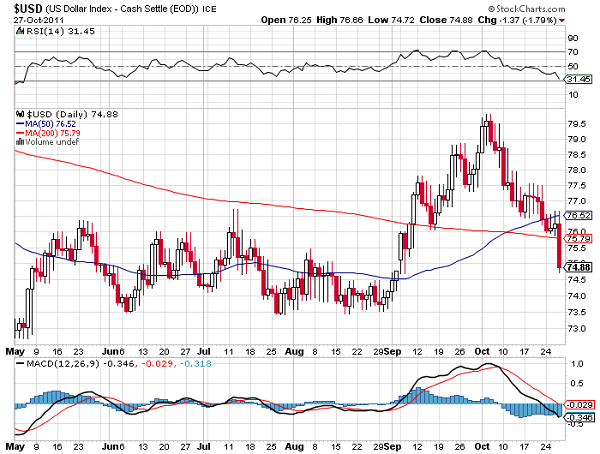The last minute deal in the Euro zone to contain the debt crisis led to a trouncing of the US dollar, and may have sealed the fate of the greenback. The agreement made in Europe on Thursday involves a 50% write-down of Greek debt and will boost the European bailout fund to as much as €1 trillion.
This deal has served to avert a collapse in the Euro zone, and sparked a rush to riskier assets and currencies at the expense of the US dollar. Throw in a surprisingly upbeat US economy, that only weeks ago was on the verge of another recession, and overnight it seems as though the global outlook is a little bit brighter.
At an interest rate of near zero that is guaranteed for at least two years, the US dollar is the first currency that is sold off when sentiment turns positive, as investors fund the market’s riskier trades with the greenback. The general return to a risk-loving environment, funded primarily with US dollars, commonly occurs when economic conditions prove to not be deteriorating.
US Dollar Falls To Multi-Week Lows

Investors prove to be slowly putting capital back to work after the past few months of market turmoil left many under-exposed to equities and risk. This widespread risk-aversion could serve to put a floor on any drop in the stock market.
The US dollar fell to a multi-week low versus the Swiss franc and the Australian dollar on the back of the European deal, while also falling to a seven-week low against the euro. While the Euro zone deal is not perfect, it appears to be a step in the right direction that has boosted confidence in the markets.
While the details will be finalized by the end of the year, the European deal has served to temporarily stem the bleeding in the region, and will hopefully serve to steer the ship in the right direction.
Optimism In The Currency Options Market
There is also a fair amount of optimism in the currency options market, with implied volatility on one month euro/dollar options, a means of measuring the expectations concerning the price action of a currency, fell from 14.85% late on Wednesday, to 13.30% on Thursday.
This decline in volatility suggests that investors are not as concerned about the European situation, and therefore see less need to hedge against a possible negative event coming from the region. Based on the risk reversal measure in the options market, sentiment on the euro, which has been fairly negative over the last few years, showed a marked improvement on Thursday.
Even though in general, investors remain bearish on the euro, risk reversals have come off of extreme levels. One-month risk reversals in euro/dollar showed bias for euro puts on Thursday, improving from as low as -3.9 vols on Wednesday to -3.3 vols on Thursday.
What’s Ahead For The US Dollar
Typical to any type of market, the decline in the US dollar will not be straightforward. If there is a delay in the implementation of the Euro zone agreement, or global credit suddenly freezes, investors will most likely buy greenbacks, a move commonly seen during times of stress in the markets.
The deleveraging of financial institutions could have implications for dollar credit, according to analysts, and if there is an impairment of dollar credit that could be supportive of the US dollar.
As central banks around the world have been extremely inclined to supply liquidity to financial institutions through their swap lines, this is something few investors have been concerned about.
The inclination to sell the dollar is in full swing, with few investors willing to go against the trend.
Comments (No)